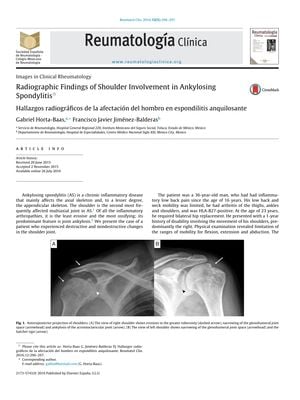Radiographic Findings of Shoulder Involvement in Ankylosing Spondylitis
July 2016
in “
Reumatología Clínica (English Edition)
”

TLDR The patient with Ankylosing Spondylitis had shoulder joint damage and bone changes.
The document reports on a 36-year-old male patient with Ankylosing Spondylitis (AS), a chronic inflammatory disease primarily affecting the axial skeleton and to a lesser extent the appendicular skeleton, with the shoulder being the second most frequently affected joint. The patient had a history of inflammatory low back pain since age 16, limited mobility in the back and neck, arthritis in various joints, and was HLA-B27 positive. He underwent bilateral hip replacement at age 23 and presented with a one-year history of shoulder movement disability, particularly in the right shoulder. Radiographic findings included bilateral grade II sacroiliitis, squaring of vertebral bodies, vertebral ankylosis from T11 to L2, and degenerative changes in the shoulders with erosions and ankylosis of the acromioclavicular joint. The study highlights that enthesitis is a common feature of AS, affecting tendons in the shoulder, and that the acromioclavicular joint is a common site of involvement in AS, with changes usually being degenerative. The case presented is notable for acromioclavicular ankylosis, a condition that should be evaluated in patients with long-standing AS and hip involvement.

